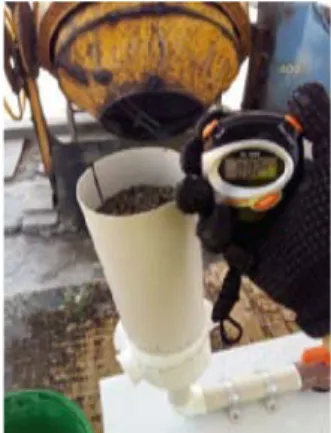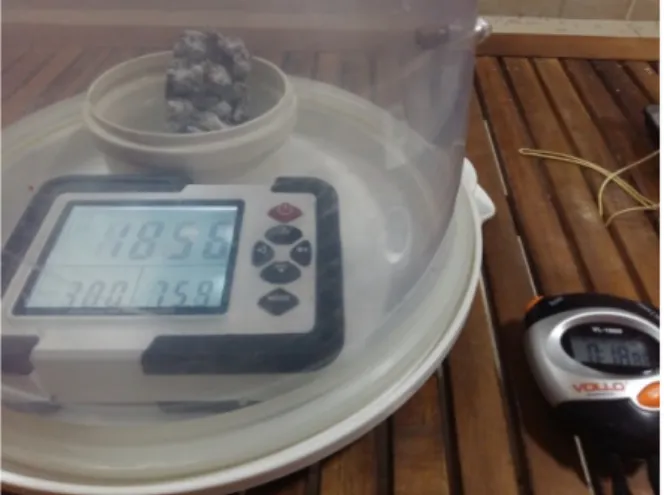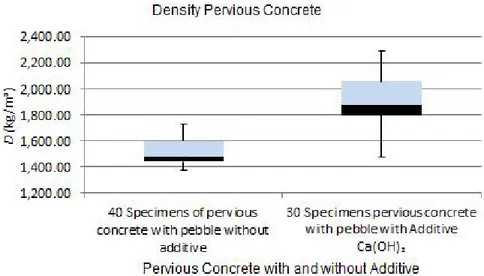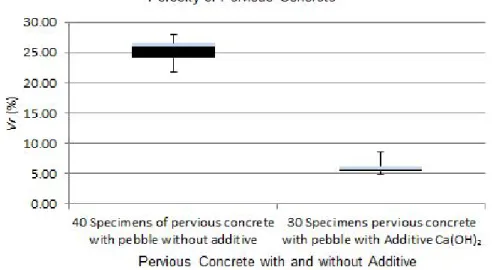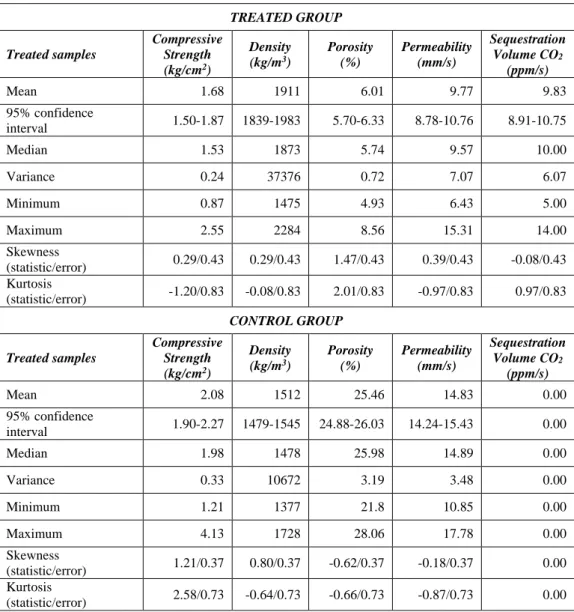Procedia
Environmental Science, Engineering and Management http://www.procedia-esem.eu Procedia Environmental Science, Engineering and Management 6 (2019) (3) 473-482Environmental Innovations: Advances in Engineering, Technology and Management, EIAETM, 23rd-27th September, 2019
COMPARATIVE STATISTICAL ANALYSIS NEW URBAN
ROAD PAVEMENT VERSUS CONVENTIONAL PAVEMENT
OF PERVIOUS CONCRETE
*Evailton Arantes de Oliveira1∗∗, Maria João Correia de Simas Guerreiro2,
Isabel Maria Abreu2, Maria Alzira Pimenta Dinis2 1 University Fernando Pessoa, Praça 9 de Abril 349, 4249-004 Porto, Portugal
2UFP Energy, Environment and Health Research Unit (FP-ENAS), University Fernando Pessoa, Praça
9 deAbril 349, 4249-004 Porto, Portugal
Abstract
This research proposes a variation to pervious concrete pavement, in which a mixture of cement, aggregates and water includes calcium hydroxide additive (Ca(OH)2). This new approach focuses on
two main environmental functions: increased permeability of urban soil favoring a decrease of total and peak runoff and resulting reduction of flood occurrence in the cities, and CO2 absorption from the
atmosphere, contributing to reduction of the negative impacts caused by the observed increased greenhouse effect in the cities. A series of 40 conventional pervious concrete pavement samples and 30 specimens of the proposed urban pavement were tested in the laboratory for permeability, density, porosity and compression resistance, and monitored for CO2 absorption. Results show that there is an
environmental benefit of CO2 sequestration when adding Ca(OH)2 to pervious concrete, but there is
also a decrease in its compressive strength and permeability.
Keywords: CO2 sequestration, road pavement, pervious concrete
1. Introduction
The special report of the Intergovernmental Panel on Climate Change (IPCC, 2018), endorsed by 192 countries, was the main decision-making tool for the Paris Agreement (UNFCCC, 2019). The same report (IPCC, 2018) indicates that a global warming scenario of 1.5°C above pre-industrial levels is safer than 2.0°C, which will promote devastating
*Selection and peer-review under responsibility of the EIAETM
∗∗ Corresponding author: e-mail: 35986@ufp.edu.pt
consequences on the environment that include loss of natural species habitats, declining polar caps and rising sea levels, with an environmental impact on the health of urban populations, livelihoods and global economic growth. Global warming is enhanced by the greenhouse effect, of which CO2 gas is a major contributor. Impermeabilization of the soil in urban areas
due to road pavements increases runoff volume and peak runoff, increasing flood risk. Pervious concrete pavements (Table 1) have been applied in urban areas to help reduce that risk.
Table 1. Definition of pervious concrete
Authors Concept
Yu et al. (2019)
Pervious concrete, also known as no-fines concrete or permeable concrete, is an environmentally friendly paving material.
Aliabdo et al. (2018)
Pervious concrete is considered as a type of lightweight porous concrete with no fine or with small percentage of fine aggregate.
Kóvac and Sicaková (2018)
The material consisting of open-graded coarse aggregate, Portland cement, water, and admixtures. The basic arrangement of composition contains mainly characterization of the aggregate: size of approximately 8 mm; sand is neglected to leave the space between grains empty.
ACI 522R-10, (2010)
Pervious concrete which is namely as a permeable concrete or porous concrete consists of cement, single size coarse aggregate, without or with low content of fine aggregate, and water.
Some authors show that concrete sequesters CO2 from the atmosphere in a reaction
commonly called carbonation, Eq.1 (Branch et al., 2018; Ho et al., 2018; Haselbach and Thomas, 2014). According to Florin and Fennell (2011), this process exploits the reversible reaction between CaO and CO2 to form calcium carbonate (CaCO3). According to Haselbach
and Thomle (2014), pervious concrete presents an internal pore network that facilitates the penetration of the gases and favors CO2 sequestration from the atmosphere through
carbonation. The cement carbonation in construction may reduce CO2 in the environment,
with a positive impact on the greenhouse effect (Eq. 1) (de Oliveira et al., 2018). Ca(OH)2(s) + CO2(g)
↔
CaCO3(s)+H2O; ∆H = - 178 kJ/mol (1)Due to the development of new urban areas, there is a great challenge in finding new ways to manage storm-water runoff. Among others, porous pavements are presented as an alternative method for storm-water control (Kóvac and Sicaková, 2018; Lori et al., 2019; Zhong et al., 2018). Because of the environmental properties, pervious concrete was chosen as the main material under study in this research.
The main objective of this study is to demonstrate that the new urban road pavement proposed in this research has properties equivalent to those of conventional urban pervious concrete road pavement. The secondary objectives are:
a) To collect data on the physical properties (compressive strength, permeability, porosity and density) and environmental properties of specimens of the new urban road pavement and of conventional urban pervious concrete pavement specimens by laboratory tests; and
b) To compare the equivalence of the data collected from the physical and environmental properties of samples of the new urban road pavement and samples of the conventional pervious concrete urban pavement, through a statistical analysis of 30 samples of the new urban road pavement with the control group of 40 specimens of the conventional pervious concrete urban pavement.
2. Materials and methods
Two groups of specimens were prepared for comparative studies. Preparation of specimens included Portland cement CP III 32, tap water and rolled pebbles between 4.8 mm and 9.5 mm diameter, a water/cement factor of 0.30, and followed the methodology proposed in ACI 522R-10 (2010). Table 2 shows characteristics of specimens.
Table 2. Specimens preparation characteristics
Treatment Sample size cement:Ca(OH)2:pebble
Conventional T0 40 1:0.00:4
Proposed T1 10 1:0.30:4
T2 10 1:0.50:4
T3 10 1:0.80:4
Pervious concrete samples were left to cure for 7 days. All samples were subject to laboratory tests for permeability, density, porosity and compressive strength, and monitored for CO2 absorption following the methodologies presented in Table 3.
Table 3. Tests and methodologies applied.
Tests Days after molding
specimens
Methodologies
Permeability 14 Batezini and Balbo (2015)
Density 7 ASTM C-127 (2007)
Porosity 7 Kóvac and Sicaková (2018)
Compressive Strength 7, 14, 28 ASTM C-39 (2005)
Monitoring of volume CO2 7 This paper
3.1. Permeability
A permeameter was built to evaluate the permeability of pervious concrete (Fig. 1). The permeability coefficient or hydraulic conductivity of the permeability was calculated by evaluated based on Eq. 2 (Batezini and Balbo, 2015).
k =VL/aht (2)
where:
k - permeability coefficient or hydraulic conductivity (mm/s) V - volume of drained water (mm3)
L - specimen length (mm)
a - permeameter PVC pipe section area (mm2) h - water column height (mm)
t - time (s) 3.2. Density tests
Density of pervious concrete specimens was evaluated under oven-dry conditions and calculated according to Eq. 3, as defined in ASTM C-127 (2007), considering dry weight and submerged weight, according to Fig. 2.
Fig. 1. Permeability test apparatus
D = 997.5A/(B-C) (3)
where:
D = density (kg/m3)
A = mass of oven-dry test sample in air, oven (kg) B = mass of saturated-surface-dry test sample in air (kg) C = apparent mass of saturated test sample in water (kg)
Fig. 2. Samples identified after weighing submerged in water
3.3. Porosity
Pervious concrete samples porosity was evaluated according to Kóvac and Sicaková (2018) as shown in Eq. (4):
Vr = (1–(w2–w1)/dV)·100 (4)
where:
Vr - porosity (%)
w2 - oven dried mass of sample (kg)
w1 - mass of sample submerged in water (kg) d - density of water (kg/m3)
V – volume of specimen (m3) 476
3.4. Compressive strength
The equipment used for the rupture tests was a calibrated and certified hydraulic press (Fig. 3), Pavitest100 (CONTENCO, 2019), with a breaking capacity up to 100 t, and a digital display. The specimens of pervious concrete were ruptured at 7, 14 and 28 days after molding, according ASTM C-39 (2005).
Fig. 3. Specimens identified for rupture tests
3.5. Monitoring of CO2 volume
A CO2/Temp/RH Data Logger with an 88.9 mm display was used for CO2 volume
monitoring. The Digital Carbon Dioxide Gas Meter is a measuring instrument for CO2,
temperature and humidity, with accuracy in the range of 0-9999 ppm CO2, with accuracy of
+/- 50 ppm CO2. Specimens were placed under a 10,000 cm3 sealed acrylic chamber. A
digital carbon dioxide gas meter and a digital timer measure CO2 changes in the atmosphere
in contact with the pervious concrete samples (Fig. 4).
Fig. 4. Monitoring the volume of CO2 (ppm) over time in an artificially isolated environment
3.6. Analysis
Treated (with Ca(OH)2) and untreated (control group) pervious concrete samples
were evaluated for normality by the Shapiro-Wilk test. The Mann-Whitney non-parametric test was applied on all variables to evaluate differences between the treated and control group. Data was analyzed with the statistical package SPSS version 25 2019.
3. Results and discussion
The results of the Permeability, Density, Porosity, Compression Strength tests will be presented in Figs. 5 to 8.
Fig. 5. Permeability coefficient of 40 permeable concrete samples (control group) and 30 samples of the new urban road pavement
Fig. 6. Density variation between control group and specimens of new urban road pavement
Fig. 7. The porosity of the new urban road pavement is smaller than that of the control group
Fig. 8. Test of the compression rupture at 28 days after of specimens molding
The permeability and porosity graphs show a tendency for results below the control group, naturally due to the pore filling by the additive added to the pervious concrete mix. The density graph shows that the new pavement is more compact than the conventional pervious concrete pavement, a characteristic also demonstrated in the permeability and porosity graphs. The compressive strength graph shows a reduction in the maximum compressive strength limit in the new urban pavement samples, which occurs as the amount of additive in the pervious concrete mix increases. Increasing the additive tends to improve CO2 absorption capacity, but also reduces the compressive strength and permeability of the
new pervious concrete pavement. A study of the ideal amount of additive in the mixture was performed by testing the 3 different proportions of additive in the 0.3, 0.5 and 0.8 fractions of Ca(OH)2 additive in the pervious concrete mixture. To verify the normality of the sample
results, a statistical study was performed next.
The results of the tests performed in this research demonstrated the statistical data listed in Table 4. This Table allows us to compare the results of the tests of Compressive Strength, Density, Porosity, Permeability and Sequestration Volume CO2 between control
group and treated group.
Table 4. Descriptive statistics for the control group (40 samples) and treated group (30 samples).
TREATED GROUP Treated samples Compressive Strength (kg/cm2) Density (kg/m3) Porosity (%) Permeability (mm/s) Sequestration Volume CO2 (ppm/s) Mean 1.68 1911 6.01 9.77 9.83 95% confidence interval 1.50-1.87 1839-1983 5.70-6.33 8.78-10.76 8.91-10.75 Median 1.53 1873 5.74 9.57 10.00 Variance 0.24 37376 0.72 7.07 6.07 Minimum 0.87 1475 4.93 6.43 5.00 Maximum 2.55 2284 8.56 15.31 14.00 Skewness (statistic/error) 0.29/0.43 0.29/0.43 1.47/0.43 0.39/0.43 -0.08/0.43 Kurtosis (statistic/error) -1.20/0.83 -0.08/0.83 2.01/0.83 -0.97/0.83 0.97/0.83 CONTROL GROUP Treated samples Compressive Strength (kg/cm2) Density (kg/m3) Porosity (%) Permeability (mm/s) Sequestration Volume CO2 (ppm/s) Mean 2.08 1512 25.46 14.83 0.00 95% confidence interval 1.90-2.27 1479-1545 24.88-26.03 14.24-15.43 0.00 Median 1.98 1478 25.98 14.89 0.00 Variance 0.33 10672 3.19 3.48 0.00 Minimum 1.21 1377 21.8 10.85 0.00 Maximum 4.13 1728 28.06 17.78 0.00 Skewness (statistic/error) 1.21/0.37 0.80/0.37 -0.62/0.37 -0.18/0.37 0.00 Kurtosis (statistic/error) 2.58/0.73 -0.64/0.73 -0.66/0.73 -0.87/0.73 0.00 In Table 4, when comparing the mean properties of the treated group with the mean properties of the control group, have 19% decrease in compressive strength, 26% increase in density, 76% decrease in porosity and 34% decrease in permeability, explained by filling the pore voids of the permeable concrete by the additive, because the more add additive to the permeable concrete mix, the better the sequestration qualities of CO2, but the physical
properties are impaired.
The control group showed normality for permeability only, whereas the treated group showed normality for compressive strength, density, and sequestration volume of CO2 (Table 480
5). Due to the non-normality of some variables/groups, the Mann-Whitney non-parametric test was applied to all variables to compare the treated group with the control group.
Table 5. Shapiro-Wilk normality test statistics
Control Group Treated Group
Statistics df Sig. Statistics df Sig.
Compressive Strength 0.92 40 0.01 0.94 30 0.07
Density 0.88 40 0.00 0.95 30 0.16
Porosity 0.91 40 0.00 0.86 30 0.00
Permeability 0.96 40 0.23 0.92 30 0.02
Sequestration Volume CO2 0.00 0.00 0.00 0.95 30 0.18
The control group is significantly different from the treated group, as observed in Table 6. The control group shows significantly higher compressive strength, porosity and permeability, whereas it shows a significantly lower density, and sequestration volume of CO2. These results imply that even though there is an environmental benefit of CO2
sequestration when adding Ca(OH)2 to pervious concrete, there is also a decrease in its
compressive strength, and permeability that will also reduce the infiltration rate.
Table 6. Mann-Whitney U test for the treated and control groups.
Process Compressive
Strength
Density Porosity Permeability
Mann-Whitney U 361.00 31.00 0.00 89.00
Significance (bilateral) 4.55e-3 1.45e-11 1.07e-12 1.30e-9 4. Conclusions
The main objective and the secondary objectives proposed in this research were achieved, because the results of the tests performed demonstrated that the properties of the proposed new urban road pavement behave similarly to the properties of the conventional pervious concrete urban road pavement, with an environmental benefit of the new pavement urban road the sequestration CO2 an average rate of 9.83 ppm/s.
However, this environmental quality gain of the new urban pavement is accompanied by a 19% decrease in compressive strength, a 26% increase in density, a 76% decrease in porosity and a 34% decrease in permeability, explained by filling the pore voids of the pervious concrete by the additive, as the more add additive to the pervious concrete mix, the better the sequestration qualities of CO2, but the physical properties are impaired. For further
research suggest new testing to find an optimal amount of additive that will balance the environmental benefits of CO2 sequestration with the physical properties of pervious
concrete.
Acknowledgements
The authors wish to thank University Fernando Pessoa, Porto, Portugal, for the guidance provided and to the company J. Nasser Engenharia for the use of its Concrete Laboratory.
References
ACI 522R-10, (2010), ACI Committee 522, Report on pervious concrete, American Concrete Institute, Farmington Hills, MI, USA.
Aliabdo A.A., Elmoaty A.E., Fawzy A.M., (2018), Experimental investigation on permeability indices and strength of modified pervious concrete with recycled concrete aggregate, Construction and
Building Materials, 319, 105-127.
ASTM-C127, (2007), Density, relative density (specific gravity), and absorption of coarse aggregate, ASTM Standard C127, West Conshohocken, PA.
ASTM-C39, (2005), Standard test method for compressive strength of cylindrical concrete specimens, ASTM Standard C39, West Conshohocken, PA.
Batezini R., Balbo J.T., (2015), Study on the hydraulic conductivity by constant and falling head methods for pervious concrete, Revista IBRACON de Estruturas e Materiais, 8, 248-259. Branch J.L., Epps R., Kosson D.S., (2018), The impact of carbonation on bulk and ITZ porosity in
microconcrete materials with fly ash replacement, Advances in Materials Science & Engineering, 103, 170-183.
CONTENCO, (2019), How to perform grinding concrete proof of bodies, mortar and rock, São José da Lapa, Minas Gerais, Brasil, On line at: https://contenco.com.br/como-realizar-a-retifica-de-corpos-de-prova/.
De Oliveira E. A., Santos M. F., Souza J. A. A., Campos A. M. L., Oliveira M. P. S. L., Guerreiro M. J. C. S., Dinis M. A. P., (2018), Environmental implications of pH in a pervious concrete pavement on highway BR-319, Amazonas, Brazil, Current World Environment Journal, 13, 187-193. Florin N., Fennel P., (2011), Synthetic CaO-based Sorbent for CO2 Capture, Energy Procedia, 4, 830–
838.
Haselbach I., Thomas A., (2014), Carbon sequestration in concrete sidewalk samples, Construction and
Building Materials, 54, 47–52.
Haselbach l., Thomle J., (2014), An alternative mechanism for accelerated carbon sequestration in concrete, Sustainable Cities and Society, 12, 25-37.
Ho L.S., Nakarai K., Ogwa Y., Sasaki T., Morioka M., (2018), Effect of internal water content on carbonation progress in cement-treated sand and effect of carbonation on compressive strength,
Cement and Concrete Composites, 85, 9-21.
IPCC, (2018), Intergovernmental Panel on Climate Change Geneva, Switzerland, On line at: https://www.ipcc.ch.
Kovac M., Sicakova A., (2018), Pervious concrete as an environmental solution for pavements: focus on key, Properties Environments, 5, 1-9.
Lori A.R., Hassani A., Sedghi R., (2019), Investigating the mechanical and hydraulic characteristics of pervious concrete containing copper slag as coarse aggregate, Construction and Building
Materials, 197, 130-142.
UNFCCC, (2019), United Nations Framework Convention on Climate Change New York, USA. https://unfccc.int/process-and-meetings/the-paris-agreement/the-paris-agreement.
Yu F., Sun D., Hu M., Wang J., (2019), Study on the pores characteristics and permeability simulation of pervious concrete based on 2D/3D CT images, Construction and Building Materials, 200, 687-702.
Zhong R., Wille K., (2018), Influence of matrix and pore system characteristics on the durability of pervious concrete, Construction and Building Materials, 162, 132–141.

